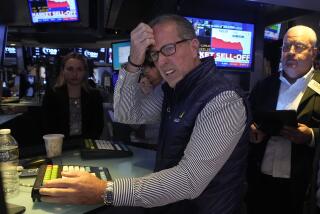Record Fund Outflow Reverses With Rally
- Share via
NEW YORK — Amid the worst market losses since at least 1987, investors pulled a record net $20.6 billion out of stock mutual funds in March, an industry trade group reported Monday.
But that cash outflow figure, which had been widely anticipated, didn’t dent fund assets for long: Some analysts estimate that investors poured as much as three-quarters of March’s outflow back into funds as the market resurged in April.
The record outflow, followed by strong inflow, may be another piece of evidence that the market has bottomed after its yearlong decline, some analysts say.
Declaring that “the bear is dead,” Alfred E. Goldman, chief market strategist at brokerage A.G. Edwards in St. Louis, said Monday that the big outflows from stock funds were consistent with his view that “the gloom hit a crescendo” in March and early April.
The $20.6-billion March net outflow, reported by the Investment Co. Institute, was a record in dollar terms but not close to a record as a percentage of fund assets.
The outflow represented 0.56% of total stock fund assets, ICI said. By contrast, investors pulled 3.1% of stock fund assets in October 1987 amid the stock market crash.
A net outflow means total redemptions of fund shares more than offset purchases of new shares. For virtually all of the 1990s, the fund industry recorded net inflow to stock funds every month.
The inflow resumed in April as stocks rocketed from their lows reached early in the month, major fund companies said Monday.
What’s more, much of the new money was directed into technology funds and other hard-hit sectors, analysts said.
As of Thursday, stock funds overall had taken in a net $9.7 billion in April, estimated Charles Biderman, president of Mutual Fund Trim Tabs research service in Santa Rosa, Calif.
Given Friday’s broad rally and Monday’s good performance by tech stocks, he estimated that equity funds finished April with inflow of $13 billion to $15 billion.
At Vanguard Group, the second biggest fund family, investors poured a net $2.2 billion into equity funds last month, a spokesman estimated. By contrast, $975 million flowed in during March, he said.
Vanguard bond funds, meanwhile, declined in popularity in April, gaining an estimated $450 million after a $1.7-billion influx in March.
Industrywide, taxable bond funds (those investing in corporate or government securities) saw a net cash inflow of $6.9 billion in March, the same as in February, ICI said. Many investors sought safety in bonds as the stock market dived.
Vanguard’s money market funds, which attracted a net $2.8 billion in March, saw outflows of an estimated $650 million during April, the company said, adding that much of the outflow was probably attributable to tax payments due April 15.
At Strong Investments, a net $146 million flowed into equity funds in April, as of Sunday, compared with a $53-million outflow in March, the firm said. Bond funds gained $12 million in April, down from $244 million in March.
T. Rowe Price also saw “really strong inflows” into equity funds in April, following “modest outflows” in March, a spokesman said.
At Invesco Funds, stock fund flows were positive in April after being “just about flat” in March, a spokeswoman said. Technology and energy were the most-attractive sector funds last month, she said.
Fidelity Investments said equity fund flows turned positive in April after two straight months of outflows.
Geoff Bobroff, an independent mutual fund industry consultant in East Greenwich, R.I., warned that fund flows may still be a sword of Damocles hanging over the market.
In volatile sectors such as technology, he said, many funds soared in 1999 and early 2000 only to crash later on. Witnessing this process has been so nerve-racking for some investors that they’ve promised themselves they will sell if their funds climb back to the price they originally paid, or close to it, Bobroff added.
Now, with tech stocks rallying, investors see an opportunity to “get even” by getting out, he said. That kind of thinking, if widespread, could create a new wave of selling that could cause stocks’ rally to stall or limit an advance, Bobroff said.
There is certainly historical precedent for redemptions to continue: After the market crash of October 1987, stock funds suffered net outflows well into the next year, even as the market recovered.
(BEGIN TEXT OF INFOBOX / INFOGRAPHIC)
Bear-Mauled
Stock mutual funds suffered their biggest net dollar outflow ever in March as the plunging market spurred some investors to flee.
Stock fund monthly net cash inflows and outflows, in billions
March: --$20.6 billion
Source: Investment Co. Institute
More to Read
Inside the business of entertainment
The Wide Shot brings you news, analysis and insights on everything from streaming wars to production — and what it all means for the future.
You may occasionally receive promotional content from the Los Angeles Times.










